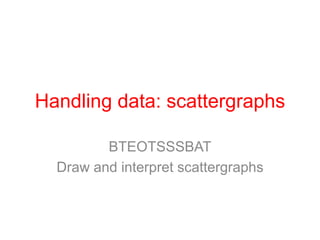
Handling data scattergraph
- 1. Handling data: scattergraphs BTEOTSSSBAT Draw and interpret scattergraphs
- 3. Correlation There are three types of correlation: positive, zero and negative. Positive Zero Negative
- 4. Strong, moderate and weak correlation The correlation can also be strong, moderate or weak. The diagrams below give examples of each for a negative correlation: Strong Moderate Weak
- 5. Example A class sat two maths tests on one algebra and another on handling data. The results are shown below: Algebra Handling data 67 52 76 56 78 72 93 84 65 43 61 78 56 67 38 34 54 62 72 77 84 84 To draw the line of best fit we must first plot the data on a scattergraph and then draw the line of best fit by eye.
- 6. Which is the harder paper? 100 90 Algebra score 80 70 60 50 40 30 20 10 0 0 20 40 60 80 100 Handling If someone scores 80 on the data score handling data how many marks would they get on the algebra paper?
- 7. Now try these The scatter graph shows the height and mass of students. Draw a line of best fit on the graph. Use the line of best fit to estimate the height of someone who has a mass of 60 kg. 80 mass/kg 70 60 50 40 140 145 150 155 160 165 170 175 180 height/ cm
- 8. What’s going on here? Do lemons cause accidents?